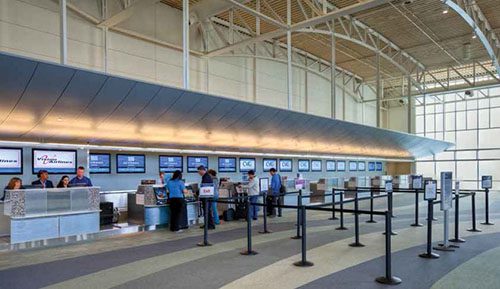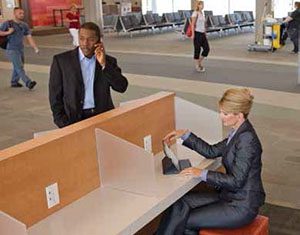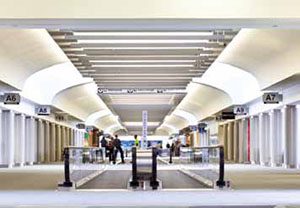
The recently renovated terminal at Cincinnati/Northern Kentucky International Airport (CVG) is a literal bricks-and-mortar representation of the dramatic contraction and changes the airport has experienced in the last seven years. The $36 million facelift and reconfiguration updates facilities for operations that used to be housed in three different terminals. Now unneeded, the other two terminals are slated for demolition in the next few years.
|
Project: Location: Cincinnati/Northern Kentucky Int’l Cost: $36 million
Est. Construction Costs:
Restroom Upgrades: Strategy: Consolidate terminals following service cuts by Delta Airlines Grand Reopening: May 2012
Prime Architect: Conceptual & Schematic Design: Architectural Alliance Construction Management: Quandel Construction Group 2035 Master Plan: Jacobs |
 A series of reductions in service by Delta Air Lines sent CVG's total passenger volume into a free-fall (see chart on Page 10) and prompted the terminal consolidation. Service cuts began shortly after the airline declared bankruptcy in 2005 and subsequently merged with Northwest Airlines. In 2008, Delta reduced capacity at CVG by 22%; another 17% decrease occurred the year after and yet another 10% drawdown occurred in June 2011. Once the airline's second largest hub and headquarters to its regional subsidiary Comair, CVG is now in the process of reinventing itself.
A series of reductions in service by Delta Air Lines sent CVG's total passenger volume into a free-fall (see chart on Page 10) and prompted the terminal consolidation. Service cuts began shortly after the airline declared bankruptcy in 2005 and subsequently merged with Northwest Airlines. In 2008, Delta reduced capacity at CVG by 22%; another 17% decrease occurred the year after and yet another 10% drawdown occurred in June 2011. Once the airline's second largest hub and headquarters to its regional subsidiary Comair, CVG is now in the process of reinventing itself.
"What we were is not what we'll be in the future," explains Candace McGraw, who was named chief executive officer in July 2011 after serving as chief administrative officer since 2009. "We're transforming from a fortress hub, where most passengers never left the building, to an O&D (origin/destination) market."
Landside changes such as enhancements to rental car operations and roadway construction to improve terminal access consequently dominate the airport's new master plan.
Forging Ahead
Expanding cargo operations and building vacation charter business figure prominently into McGraw's more immediate turnaround strategy. "DHL has invested $105 million in capital projects here the last several years," she explains. "They've expanded from 1,600 to 2,300 employees and are now running more than 50 flights per night."
Already accounting for fully 40% of the airport's total landed weight (and also landing revenues), DHL is a valued business partner. "They're the cornerstone for our economic and business development strategy," says McGraw. "They lease land from us and create jobs within the community. It's a win/win."
 CVG, in turn, is one of DHL's three global "superhubs." The others are located in Hong Kong and Germany.
CVG, in turn, is one of DHL's three global "superhubs." The others are located in Hong Kong and Germany.
Vacation charters by Apple and Vacation Express are another bright spot for the airport. Traffic on Frontier and Sunwing Airlines to destinations like Punta Cana, Cancun and Montego Bay actually grew while overall traffic plummeted.
But there's still the overall passenger service issue to face. Local businesses have been vocal about the damaging effects of high fares and schedule slashing by Delta. When Chiquita Brands announced plans to move its headquarters from Cincinnati, the company acknowledged it was looking forward to better international flight options in its new hometown, Charlotte, NC. In December, Ohio Governor John Kasich didn't mince words when he charged CVG with "holding (the area) back big time." He also fired a shot at Delta for holding the market "captive."
Airport officials stress their efforts to find a low-cost carrier to local media. While McGraw has characterized replacing lost domestic service as her "highest priority," she reminds the community that adding more international routes is a long-term process.
Rumors periodically swell and subside about the possibility of a new carrier, with Southwest Airlines and JetBlue Airways mentioned as likely suspects. One end of Concourse A stands ready for the to-be-determined tenant, complete with empty gates and new holdroom furniture.
"Traffic with Delta has stabilized, and we're even seeing some growth with other airlines," reports McGraw.
Last spring, US Airways added three daily flights to Reagan National Airport – a move that decreased fares to Washington D.C. by 16%, notes Larry Savage, chairman of the airport board's air service committee. An even larger increase followed in summer, when United Airlines added 17 flights a week to Houston and Newark, N.J. The uptick continued in December, when the airport announced that US Airways would add another daily nonstop to Reagan National in February.
The carrier's service expansion began after it moved from Terminal 2, notes McGraw. "Previously, they were facility-constrained," she explains.
Delta, which once occupied all of Terminal 3, now operates out of 39 gates in its B concourse. Notably, the airport expects "dramatic non-reductions" from the airline in the first quarter of 2013. Other carriers previously housed in Terminal 2 (Air Canada, American Airlines, Continental Airlines, US Airways and United Airlines) were moved into Delta's previous space in Concourse A. Ticketing and Security for all carriers were consolidated into Terminal 3, which is now simply referred to as "the Terminal." Terminal 1 currently houses the airport's executive and administrative offices.
Renovating Concourse A, which had been "mothballed" during the Delta cutbacks, was one of the renovation's major elements.
New Look, New Amenities
When conceiving the conceptual and schematic designs for the project, Architectural Alliance focused on updating the facilities and making the airport more user-friendly – especially to business travelers, notes McGraw. The airport added free Wi-Fi, installed new carpet and painted walls. Gates received updated furniture, with extra side tables and electrical outlets/USB ports.
"Now every seat is like an end seat," says McGraw. "We never want to see a passenger sitting on the floor just to use an outlet." In addition, each holdroom now has workstations for passengers.
Designers modified the terminal's flow to improve the overall passenger experience and help increase revenue from concessions. New main entry doors eliminate a previous pinch point, flight information displays were relocated and reconfigured, and, most importantly, ceilings and lighting were completely revamped, notes Tom Hysell, principal with Architectural Alliance.
"The entire concourse is brighter, more open, and the passengers clearly know where to go," he relates.
Improvements to the underground pedestrian tunnel that connects Ticketing to concourses A and B were among the project's most dramatic enhancements, says Hysell. Once described by airport officials as "dark, foreboding and uninviting," the new space is lighter and brighter. "It was mostly transformed with lighting and graphics," he explains. "The difference is pretty amazing."
Previously, the majority of passengers rode the airport train to concourses A and B. Since the tunnel's makeover, however, most now choose to walk or use the moving walkways. "The renovations are actually changing passenger behavior," relates McGraw.
 Other standout upgrades include the restrooms and Ticketing, notes Keith Hall, principal of with MSA Architects. "This was the first real improvement to Concourse A in more than 20 years," Hall explains. "Previously, everything was 'Delta blue' and heavily branded with the airline's logo."
Other standout upgrades include the restrooms and Ticketing, notes Keith Hall, principal of with MSA Architects. "This was the first real improvement to Concourse A in more than 20 years," Hall explains. "Previously, everything was 'Delta blue' and heavily branded with the airline's logo."
The new color palette uses natural tones – browns, greens and beiges. In addition, brightly colored screens "pump life" into the holdrooms and tunnel, he notes.
McGraw describes the new ticketing area as "carrier agnostic," with airline branding achieved exclusively through monitors. "We operate the backbone system, and carriers plug their systems in," she explains. "Airlines don't want to have to invest capital, so we're making it easy for them to come in. We can add or contract space in a very non-capital intense way."
The airport also spent about $1 million upgrading its restrooms. "We completely gutted them and took everything to a whole new level," Hall explains. Marble partitions, new lighting and beautiful wall tile put CVG's restrooms on par with high-end hotels, he adds. New layouts place paper towel dispensers and hand dryers directly behind the sinks. "Hands dripping on the floor can create slip and fall hazards," notes Hall. "We kept everything close together to reduce that risk."
 The Meaning Behind the Look
The Meaning Behind the Look
Hall and Hysell both credit Kolar Design for conceiving the bold color panels that may well become the airport's signature elements. "They did a great job developing themes about the region and translating them into interior finishes," says Hall.
The firm takes a multidisciplinary approach that encompasses architecture, interior/industrial design and graphics to create "branded environments," explains company founder/president Kelly Kolar. "We thrive on the challenge of helping organizations create meaningful, memorable and measurable experiences (for customers) by leveraging their real estate," Kolar elaborates. Cincinnati-based Proctor & Gamble, now known simply as P&G, is also a current client.
As a local, Kolar knows that CVG has experienced a "crisis of confidence" in the community. One of the challenges the airport faces, she notes, is the proximity of five strong competitors within a two-hour driving radius: Dayton International and Port Columbus International in Ohio; Louisville International and Lexington Blue Grass Airport in Kentucky; and Indianapolis International in Indiana.
"Consumers want low fares and lots of flight options," Kolar relates. "Many turned their backs on CVG because of Delta's decisions. We helped them leverage their real estate and built environment to help win back the hearts and minds of CVG passengers – and attract new ones."
When Kolar interviewed for the job, she was also helping develop overarching "story" themes about the region for a cooperative venture between the Greater Cincinnati Chamber of Commerce and Northern Kentucky's Vision 2015. "It was the perfect storm," she recalls. "We were able to leverage regional cooperative marketing efforts and concepts that had already been researched, and use them at the airport."
|
ID Please As Cincinnati/Northern Kentucky International Airport (CVG) reconfigures its facilities in response to dramatic service reductions by Delta Airlines, officials work to reinvent the organization as a whole. But it’s not the first time the airport has faced identity issues. Being located in Kentucky but largely sustained by business from Ohio creates unique local challenges, with some Kentuckians feeling like overlooked stepchildren. In addition, the airport was built in one county (Boone) but is owned and operated by another (Kenton). There’s even a twist to its three-letter identifier. CVG refers not to its hometown of Hebron, but Covington, the nearest sizable town when the airport was built in 1947. The marketing staff, however, prefers the explanation of astronaut and former CVG board member Neil Armstrong: Cincinnati – Very Good. |
The Ohio River, which runs through all of the groups' constituencies, became the centerpiece visual/symbol. Historic "River City Mosaics," 20-foot long Art Deco murals from Franklin Roosevelt's New Deal era in the late 1930s, were consequently shipped from Cincinnati's Union Terminal railroad station for use at the airport. "They're monumental, invaluable pieces that depict local industry, planes, trains and riverboats – Cincinnati themes of the past," explains Kolar. "They illustrate the neighborhoods, people and diversity of the area beautifully and were woefully underutilized before."
The river theme also appears in the tunnel's carpeting – with contours and curves designed to encourage passengers to relax and meander, as if following the banks of the Ohio. The local newspaper, the Cincinnati Enquirer, provided photographs of the area's people and places. "It's an unbelievable collection," raves Kolar. "And since they're panoramic, they're perfect for the long tunnel."
Kolar used the artwork, interior finishes and graphics to help add "sense of place" to the airport. "We want CVG to reflect our unique topography; it's who we are at a DNA level," she relates.
Airside, Landside, Fun Side
Beyond aesthetic upgrades, CVG makes serious efforts to lighten the mood in the terminal with live performances by groups including the Cincinnati Ballet, an African drum ensemble, the Cincinnati Shakespeare Company and Irish dancers (a personal request for St. Patrick's Day by the airport's Irish CEO). "The live entertainment injects a flavor of what goes on the in arts around Cincinnati," McGraw relates.
And you won't hear any Muzak in the terminal. CVG's soundtrack is strictly classical music played by the Cincinnati Symphony Orchestra and "coffeehouse selections" from Northern Kentucky University.
"We like to showcase our local talent whenever we can," notes McGraw.
Toward that end, CVG is in the process of adding a kiosk program to its concessions lineup to feature the work of local artists and artisans.
On the less esoteric side, a video that instructs passengers on security procedures features the three Cincinnati Reds mascot characters. "Baseball is like a religion here," explains McGraw, "so the passengers really tune in to the video. It lightens the mood at the checkpoint, and TSA tells us that people pay more attention to the instructions." To view the video, visit www.cvgairport.com/about/news/vid.html.
No Time to Rest
Given its beleaguered past and the challenging local conditions that still prevail, predicting what's ahead is understandably difficult at CVG. In spring 2011, the airport hired Jacobs to support its master planning process.
"Traffic forecasting was more of a challenge than usual," recalls Julie Kenfield, senior aviation planner with Jacobs. "We couldn't rely on typical methods like regression analysis of historical growth; we had to use pertinent socioeconomic data."
 With such a volatile market, though, that didn't provide clear answers, either. "Despite growth in the community and a reasonable business climate, traffic hadn't grown the way the gross regional product and population had," Kenfield explains. "Passengers were obviously willing to drive for the lowest fare."
With such a volatile market, though, that didn't provide clear answers, either. "Despite growth in the community and a reasonable business climate, traffic hadn't grown the way the gross regional product and population had," Kenfield explains. "Passengers were obviously willing to drive for the lowest fare."
That led Jacobs to benchmark CVG against a group of peer airports, representing approximately 26 million passengers in 2010, to determine an endpoint of "what could be" for the airport. Planners then vetted the forecast data with the airport. "We had a whole lot of discussions with staff about how to recapture their market and what that performance might look like for CVG," she recalls.
Jacobs developed separate forecast scenarios based on slow growth and a bump in traffic associated with the introduction of a low-cost carrier. Forecasts of demand were coupled with projections about both capital and ownership costs of various systems and facilities. "We determined when the airport would have to make significant investments in existing facilities based on historic operations and maintenance data and industry (averages)," explains Kenfield. "That way, we were able to provide a picture of the total cost of ownership of various scenarios. We could project when they could use a capital investment in a new facility to offset major O&M (operations and maintenance) costs."
Given the recent terminal updates and an estimated 10 years of life left in the concourses, master plan elements proposed for 2016 to 2025 focus on landside improvements: a new consolidated rental car center, additional parking for increased local travelers, a stop for regional bus lines and access road enhancements.
 Airfield projects are notably absent from the airport's plans, notes McGraw. "We have three parallel runways with good separation, plus another cross-wind runway," she chronicles. "Our airfield is a marvelous asset."
Airfield projects are notably absent from the airport's plans, notes McGraw. "We have three parallel runways with good separation, plus another cross-wind runway," she chronicles. "Our airfield is a marvelous asset."
Shorter-term plans include revamping the food court and gateholds in Concourse B and adding a universal business lounge developed with Grey Cliffs.
Collateral commercial development is also being considered. "We have 7,500 acres – 4,400 inside the fence," McGraw explains. "We have great sites ripe for development."
In the meantime, CVG is enjoying its update. "The public loves it," reports McGraw. "We've had nothing but positive feedback."
Last year, CVG was named Best Regional Airport in North America for the second year in a row by SkyTrax. The airport also recently earned its best quarterly results in the Airport Service Quality survey. McGraw is quick to acknowledge the staff's role in the accomplishments: "Our employees are on board 100%. They have great esprit de corps and realize that the way we do our jobs affect how people out in the community do theirs."
As the airport evolves from a former Delta hub into an emerging O&D airport and DHL stronghold, employees will continue to be a critical factor, says McGraw. "We're reinventing the airport," she explains, "and that requires everyone."



